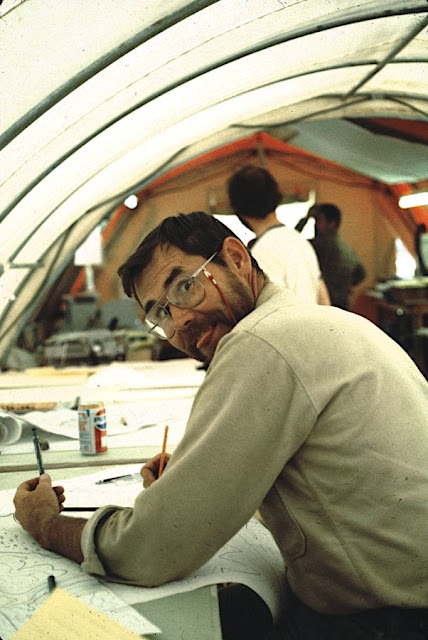 |
| Dr. Paul Graff, 1988, Snow Gulch, Alaska. |
I was sadden to hear we lost another member of the Donlin Creek discovery crew! My best friend, Dr. Paul Graff passed away on March 2nd, 2023. He had a spirit that would infect anyone with laughter and happiness, so it is difficult for me to lose such a close friend. The world lost one of the greatest exploration geologists of the 20th and 21st centuries.
Paul was my best friend! I met him in 1977 at the University of Wyoming while completing his PhD dissertation. Since then, we developed a close friendship lasting 45 years. I always looked forward to seeing Paul when he stopped by my office at the Wyoming Geological Survey at the University of Wyoming, as well as the days we broke rocks on the outcrop together. Then there were the times we exchanged prospector stories and lies in my office.
One of the greatest experiences of my life was when Paul hired me to search for gold in Kuskokwim Mountains of Alaska in 1988 and 1989 for WestGold (a subsidiary of DeBeers and Selection Trust). What a great time! Bears, bush pilots, rocks, gold, eskimos, caribou, and bears! I know I said bears twice - but that's because they were so much bigger in Alaska than in Montana and Wyoming. Paul and I were tent mates and I shared the art of pranking with Paul, something I was pretty good at.
Paul was a wonderful victim: he was always so focused on gold and rocks that he always missed how sticks and stones ended up under his sleeping bag, or how the outhouse got locked, why his Mills Brothers tape was floating in the Donlin Creek pond, or where did my camera go when he was about to be carried of by thousands of mosquitos.
Paul was squatting down looking at an ATV smashed by a D9 Cat, and his back immediately became infested by more mosquitos than found in the entire lower 48. I told Paul to hold still because I was tying to snap a picture of the hoard of mosquitoes on his back for my next talk to the Wyoming Geological Association in Casper. He tried to hold still for a minute, but then the bites got the best of him, so he squirmed. "Come on Paul, you were an airborne Ranger, surely you can hold still for another 30 seconds so I can get a photo". On the third try, Paul replied, "Damned it Hausel, if you don't have the photo by now, then heck with it". I was shocked, that was the first time I ever heard Paul swear. And as he turned around to face me to again announce he had enough of posing - he noticed I didn't have a camera.
Thank you so very much Paul for the wonderful memories. God bless you! I look forward to the time I will see you in God's gold fields in another dimension. For those of you who did not know Paul, you missed out on one of the greatest experiences in life. Rest in peace my friend!
Some years prior to his illness, Paul and I went to the Iron Mountain kimberlite district in the Laramie Mountains so I could show him some of the kimberlite complex. Along the way, we came across specimens of a mineral known as picroilmenite - a distinctly rounded, black, metallic mineral found in kimberlite. We came across a specimen in the field that I showed Paul. So, at the next spot, Paul thought he had found one. So he picked it up, licked it to clean off the surface of the mineral, and started spitting profusely.
I looked at him curiously - after he stopped spitting. He looked at me and said, "Elk droppings look like picroilmenite. So after considerable laughter, I decided to acknowledge Paul in one of my books - "Minerals and Rocks of Wyoming" WGS Bulletin 72, on page 88. I wrote a personal communication from Paul about mineral identification of ilmenite, and mailed a copy of my book to him. But to make him feel better about his error, I told him, yes, they look similar; however, one is moist, soft, and has a low specific gravity, and a distinct salty taste, and rotten egg gas odor.
Thank you for the many, many wonderful memories Paul. Paul, along with a mutual friend of ours, Dr. Gordon Marlatt, were the two best geologists I ever knew!
Rest in Peace my friend!





